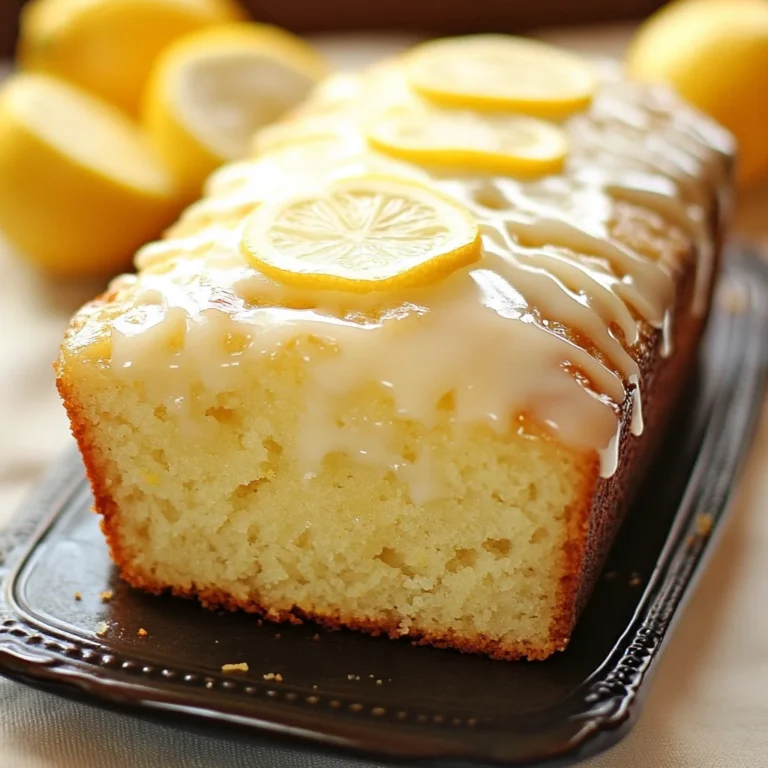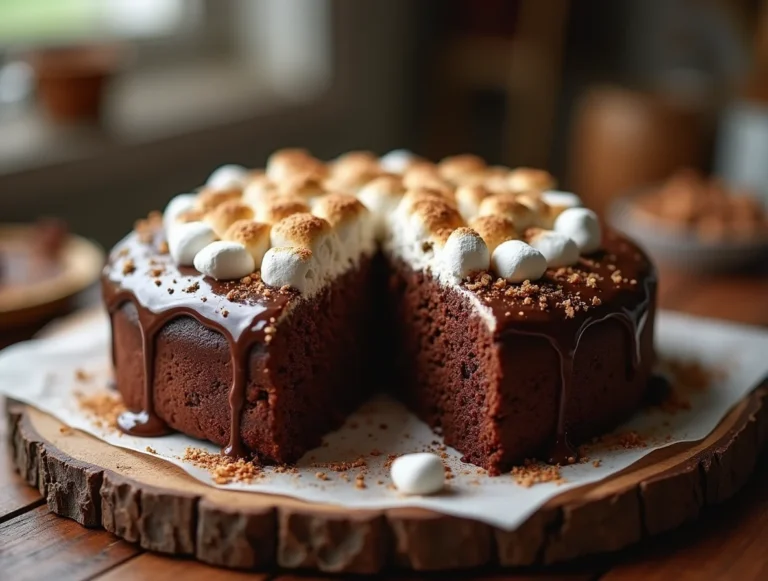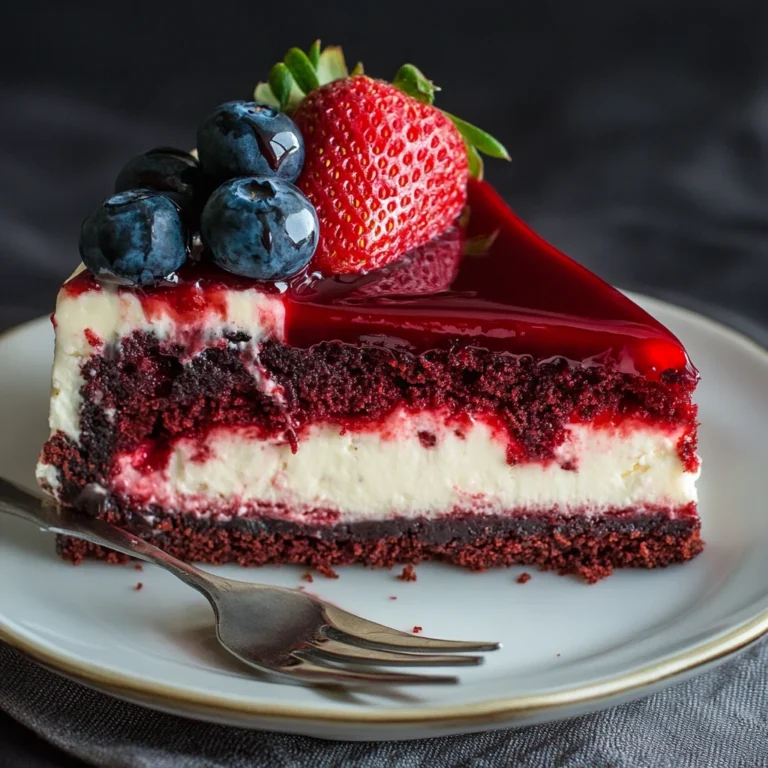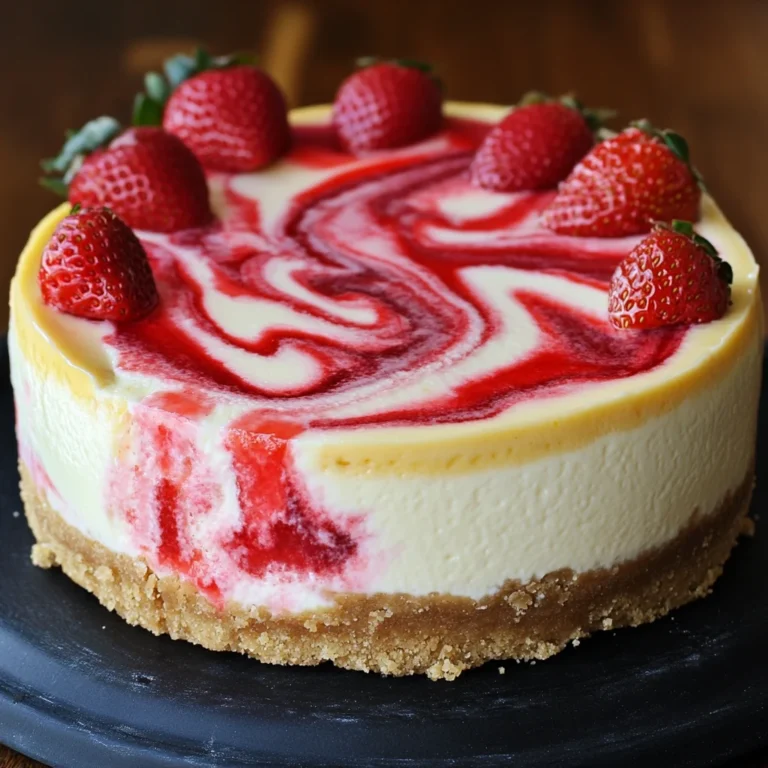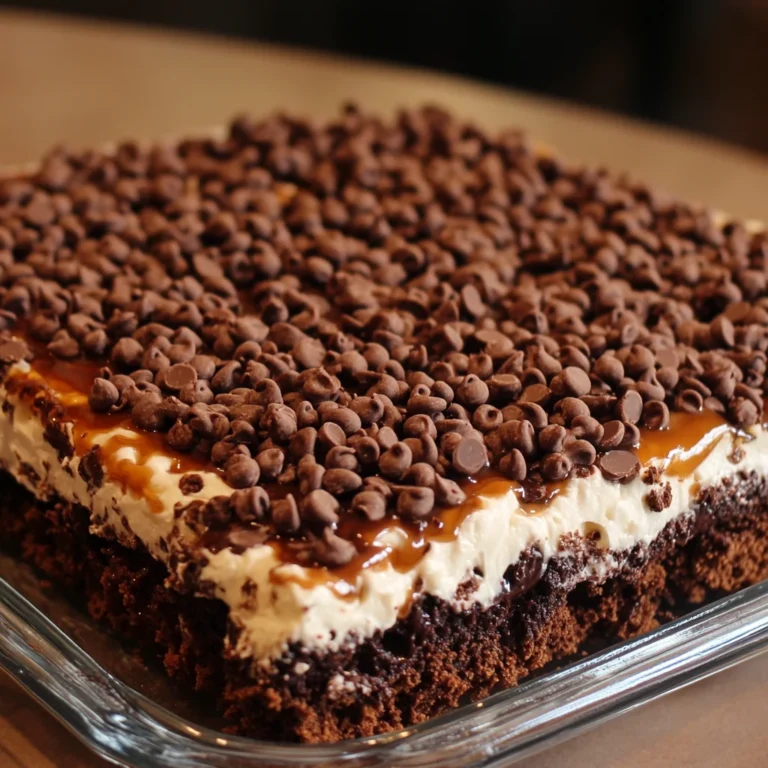Lemon Blueberry Cake
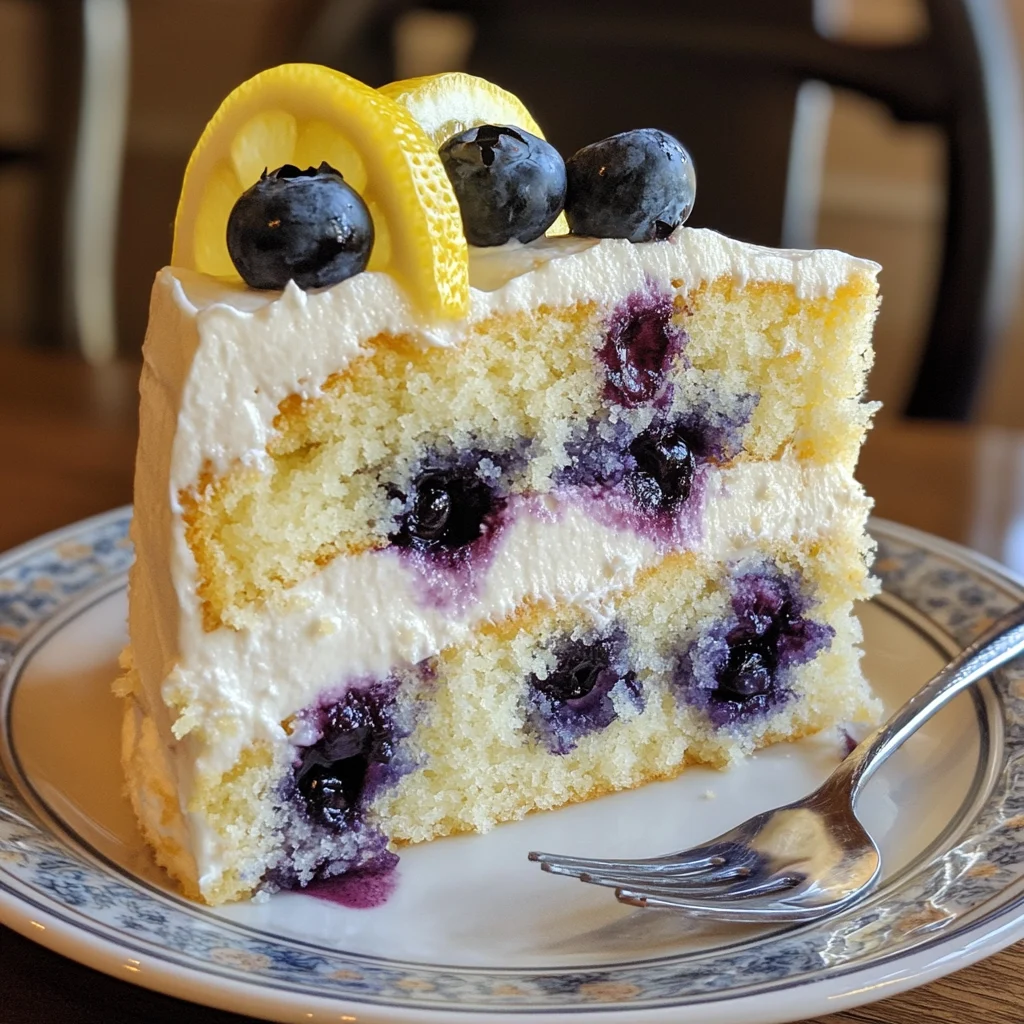
Description: This Lemon Blueberry Cake is a delightful symphony of flavors and textures. A moist, tender lemon cake is generously studded with juicy blueberries and crowned with a luscious lemony mascarpone frosting. Layers of mascarpone whipped cream and tangy lemon curd are nestled between cake layers, creating an unforgettable dessert experience. It’s the perfect cake for spring or summer gatherings, afternoon tea, or simply a special treat for yourself.
Why you will love this recipe:
- Incredible Flavor: The combination of bright lemon and sweet blueberries is a match made in heaven. The mascarpone frosting adds a creamy richness with a subtle tang, complementing the other flavors beautifully.
- Moist and Tender: Thanks to the oil-based batter and the addition of sour cream and buttermilk, this cake stays incredibly moist for days. You won’t have to worry about it drying out!
- Impressive Presentation: With its layered construction, piped frosting, and fresh fruit garnish, this cake is a showstopper. It’s sure to impress your guests and make any occasion feel a little more special.
- Make-Ahead Friendly: The cake layers can be baked a day in advance and stored at room temperature. The frosting can also be made ahead and refrigerated. This makes it easier to assemble the cake when you’re ready to serve it.
- Adaptable: Feel free to adjust the sweetness or tartness to your liking. You can also experiment with different types of berries or add a lemon glaze for an extra touch of flavor.
Introduction
Lemon Blueberry Cake is more than just a dessert; it’s an experience. The bright, zesty lemon notes awaken the palate, while the burst of sweet blueberries provides a delightful contrast. The creamy mascarpone frosting adds a touch of elegance, and the layers of lemon curd create a tangy surprise in every bite. This cake is a celebration of simple, fresh ingredients transformed into something truly special.
The recipe uses an oil-based cake as a base which is known for keeping cakes incredibly moist. The key to a great lemon flavor is using both the zest and the juice of fresh lemons. The zest provides the aromatic oils that give the cake its distinct lemon flavor, while the juice adds a tangy acidity that balances the sweetness. Mascarpone cheese is a key ingredient that makes the mascarpone frosting, and the light lemon curd. Using fresh, ripe blueberries is essential for the best flavor and texture.
Ingredients:
For the Cake:
- 2 cups (380g) granulated sugar
- ½ cup (118 ml) vegetable oil
- 3 large eggs
- 2 lemons, zested and juiced (yielding ¼ cup juice)
- 1 teaspoon (5ml) lemon (or vanilla) extract
- ½ cup (118 ml) light sour cream
- 2 ½ cups (350 g) all-purpose flour
- 3 teaspoons (11.2 g) baking powder
- 1 teaspoon (5 g) salt
- 1 cup (236 ml) buttermilk (or milk)
- ¼ cup (59ml) fresh lemon juice
- 9 ounces fresh blueberries, washed and dried
- 2 tablespoons (15.6g) all-purpose flour
For the Frosting:
- 2 ¼ cups (532ml) heavy whipping cream
- 1 cup (130g) powdered sugar
- 1 teaspoon (5ml) pure vanilla extract
- 16 ounces mascarpone cheese, cold
For the Filling:
- 1 jar (10 ounces) lemon curd

Preparation:
For the Cake:
Step 1: Preheat the oven to 350°F (175°C). Prepare three 8-inch round baking pans by lining the bottoms with parchment paper and greasing the sides. If desired, use bake-even strips wrapped around the pans to promote even baking and prevent doming.
Step 2: In a large mixing bowl, combine the sugar, vegetable oil, eggs, and lemon extract. Beat on medium speed until the eggs and oil are well incorporated and the batter is lighter in color, about 2 minutes. Scrape down the bowl as needed to ensure all ingredients are evenly combined.
Step 3: Zest 2 lemons directly into the batter, capturing all those fragrant oils. Then, juice the lemons to obtain ¼ cup of fresh lemon juice. Add the lemon zest, lemon juice, and sour cream to the batter. Beat until well combined, ensuring the lemon flavors are evenly distributed throughout.
Step 4: In a separate bowl, whisk together the dry ingredients: flour, baking powder, and salt. This ensures that the baking powder is evenly distributed, resulting in a cake that rises uniformly.
Step 5: Gradually add the dry ingredients to the wet ingredients, alternating with the buttermilk. Begin by adding half of the dry ingredients to the batter, beating on low speed while pouring in half of the buttermilk. Mix just until the flour starts to incorporate. This prevents overmixing, which can lead to a tough cake. Add the remaining dry ingredients and remaining buttermilk, beating until all ingredients are well combined. Be sure to scrape down the sides of the bowl to ensure even mixing.
Step 6: Use a spatula to scrape down the sides of the bowl and stir the batter from the bottom to the top to ensure it’s well mixed. This ensures that no pockets of unmixed ingredients remain.
Step 7: In a separate small bowl, toss the blueberries with 2 tablespoons of flour. This helps prevent the blueberries from sinking to the bottom of the cake during baking. Gently fold the blueberries into the batter, saving a small handful to drop on top of the cake batter.
Step 8: Divide the batter evenly between the three prepared pans, about 1 2/3 cups of batter per pan. Drop the remaining blueberries on top of the batter in each pan. This ensures that the blueberries are evenly distributed throughout the cake.
Step 9: Bake at 350°F (175°C) for 20-23 minutes. Rotate your pans in the oven halfway through baking to ensure even browning. Test the cake for doneness by inserting a toothpick into the center of the cake. If the toothpick comes out clean or with a few moist crumbs, the cake is done.
Step 10: Remove the cakes from the oven and allow them to cool in the pans for 10 minutes before inverting them onto a wire rack to cool completely.
For the Frosting:
Step 1: Place the mixing bowl and whisk attachment in the freezer for 5 to 10 minutes to chill. This helps the mascarpone and heavy cream whip up more quickly and easily.
Step 2: Spoon the cold mascarpone cheese into your chilled bowl and beat on a medium-low speed (speed 3 on your stand mixer). Slowly pour in the heavy cream, allowing the mascarpone cheese to turn to a liquid consistency. This slow addition of the heavy cream prevents the mascarpone from clumping.
Step 3: Increase the mixing speed to high (speed 8-10) and beat until soft peaks form. Be careful not to overbeat, as this can cause the mascarpone to curdle.
Step 4: Add the powdered sugar and vanilla extract, beating on low until the sugar is incorporated. Then continue beating at high speed until stiff peaks form. This will give you a stable and beautiful frosting.
Assembly:
Step 1: Use a cake leveler or a serrated knife to cut the domes off the top of the cake layers, creating a flat surface for stacking.
Step 2: Place a dollop of frosting on your cake board or serving plate to secure the bottom layer of cake. Place the bottom layer of cake on top of the frosting.
Step 3: Place half of the mascarpone whipped cream in a large piping bag fitted with a large open round tip, or simply cut off the end of the piping bag. Pipe a layer of frosting onto the cake layer and spread evenly. Then spread half of the lemon curd over the mascarpone filling.
Step 4: Add the second layer of cake and repeat the above steps using all of the remaining lemon curd.
Step 5: Add the final layer of cake on top.
Step 6: Use your piping bag to fill in any gaps between your layers and to create a crumb coat. A crumb coat is a thin layer of frosting that seals in any crumbs and creates a smooth surface for the final frosting layer.
Step 7: Using an offset spatula or icing smoother, wipe away the excess frosting, leaving you just enough to coat the outside of the cake. Do not mix your crumb coating frosting back into your icing if it has cake debris in it.
Step 8: Proceed to frost the top and sides of the cake using your offset spatula. Once the sides of the cake are covered, use an icing smoother to remove any excess frosting and create a smooth finish. You can take the end of your offset spatula and gently place them against the sides of the cake as you rotate your cake to add a little texture.
Step 9: Use the remaining frosting to pipe florets on the top of the cake using an Ateco 809 tip (large open round) or your favorite piping tip. Garnish with lemon slices and leftover blueberries for a beautiful and elegant presentation.
Step 10: Refrigerate the cake for at least 30 minutes to allow the frosting to set before serving. This will make it easier to slice and serve.
COOKING Rating:
- Difficulty: Intermediate
- Taste: 5/5
- Presentation: 5/5
Serving Suggestions:
- Serve chilled or at room temperature.
- Pairs well with a cup of tea or coffee.
- A scoop of vanilla ice cream or a dollop of whipped cream makes a delicious addition.
- Garnish with fresh mint sprigs for an extra touch of freshness.
Tips:
- Use room-temperature ingredients for the best results.
- Don’t overmix the batter, as this can lead to a tough cake.
- Be careful not to overbeat the mascarpone frosting, as this can cause it to curdle.
- If you don’t have buttermilk, you can make a substitute by adding 1 tablespoon of lemon juice or white vinegar to 1 cup of milk. Let it sit for 5 minutes before using.
- To prevent the cake layers from sticking to the pans, make sure to grease them well and line them with parchment paper.
- Store leftover cake in the refrigerator for up to 3 days.
Prep Time: 15 minutes
Cook Time: 23 minutes
Total Time: 38 minutes
Nutritional Information:
- Calories: Approximately 450 per slice (estimate, will vary based on portion size and specific ingredients)
- Protein: Approximately 5g per slice
- Sodium: Approximately 200mg per slice
Conclusion
The Lemon Blueberry Cake is a show-stopping dessert that is sure to impress your family and friends. With its moist cake, bright lemon flavor, sweet blueberries, and creamy mascarpone frosting, it’s a truly unforgettable treat. Whether you’re celebrating a special occasion or simply want to indulge in something delicious, this cake is the perfect choice. Don’t be intimidated by the number of steps; each one is simple and straightforward, and the end result is well worth the effort. Enjoy!
Questions and Answers about Lemon Blueberry Cake:
Q1: Can I use frozen blueberries instead of fresh?
A: While fresh blueberries are ideal for their plumpness and vibrant flavor, frozen blueberries can be used in a pinch. However, it is important to not thaw the blueberries as this can make the batter too wet. Toss the frozen blueberries with the flour directly from the freezer and gently fold them into the batter. You might need to increase the baking time by a few minutes, as frozen blueberries can lower the batter’s temperature.
Q2: I don’t have mascarpone cheese. Can I substitute something else?
A: Mascarpone cheese provides a unique richness and subtle tang that complements the lemon and blueberries. However, if you don’t have it, you can substitute it with an equal amount of cream cheese, but be sure to use full-fat cream cheese for the best texture.
Q3: Can I make this cake gluten-free?
A: Yes, you can make this cake gluten-free by substituting the all-purpose flour with a gluten-free all-purpose flour blend. Be sure to choose a blend that contains xanthan gum or add it separately (about 1 teaspoon per cup of flour) to provide structure and prevent the cake from becoming crumbly. The rest of the recipe remains the same.
Q4: How can I prevent the cake layers from doming?
A: Doming is a common issue when baking cakes. To prevent doming, make sure your oven temperature is accurate, and don’t overfill the pans. Using bake-even strips wrapped around the pans can also help regulate the temperature and promote even baking.
Q5: Can I make this cake ahead of time?
A: Absolutely! The cake layers can be baked a day or two in advance and stored at room temperature, tightly wrapped in plastic wrap. The mascarpone frosting can also be made a day in advance and stored in the refrigerator. However, it is best to assemble the cake on the day you plan to serve it to prevent the frosting from drying out.

Lemon Blueberry Cake
Ingredients
- For the Cake:
- 2 cups 380g granulated sugar
- ½ cup 118 ml vegetable oil
- 3 large eggs
- 2 lemons zested and juiced (yielding ¼ cup juice)
- 1 teaspoon 5ml lemon (or vanilla) extract
- ½ cup 118 ml light sour cream
- 2 ½ cups 350 g all-purpose flour
- 3 teaspoons 11.2 g baking powder
- 1 teaspoon 5 g salt
- 1 cup 236 ml buttermilk (or milk)
- ¼ cup 59ml fresh lemon juice
- 9 ounces fresh blueberries washed and dried
- 2 tablespoons 15.6g all-purpose flour
- For the Frosting:
- 2 ¼ cups 532ml heavy whipping cream
- 1 cup 130g powdered sugar
- 1 teaspoon 5ml pure vanilla extract
- 16 ounces mascarpone cheese cold
- For the Filling:
- 1 jar 10 ounces lemon curd
Instructions
- For the Cake:
- Step 1: Preheat the oven to 350°F (175°C). Prepare three 8-inch round baking pans by lining the bottoms with parchment paper and greasing the sides. If desired, use bake-even strips wrapped around the pans to promote even baking and prevent doming.
- Step 2: In a large mixing bowl, combine the sugar, vegetable oil, eggs, and lemon extract. Beat on medium speed until the eggs and oil are well incorporated and the batter is lighter in color, about 2 minutes. Scrape down the bowl as needed to ensure all ingredients are evenly combined.
- Step 3: Zest 2 lemons directly into the batter, capturing all those fragrant oils. Then, juice the lemons to obtain ¼ cup of fresh lemon juice. Add the lemon zest, lemon juice, and sour cream to the batter. Beat until well combined, ensuring the lemon flavors are evenly distributed throughout.
- Step 4: In a separate bowl, whisk together the dry ingredients: flour, baking powder, and salt. This ensures that the baking powder is evenly distributed, resulting in a cake that rises uniformly.
- Step 5: Gradually add the dry ingredients to the wet ingredients, alternating with the buttermilk. Begin by adding half of the dry ingredients to the batter, beating on low speed while pouring in half of the buttermilk. Mix just until the flour starts to incorporate. This prevents overmixing, which can lead to a tough cake. Add the remaining dry ingredients and remaining buttermilk, beating until all ingredients are well combined. Be sure to scrape down the sides of the bowl to ensure even mixing.
- Step 6: Use a spatula to scrape down the sides of the bowl and stir the batter from the bottom to the top to ensure it’s well mixed. This ensures that no pockets of unmixed ingredients remain.
- Step 7: In a separate small bowl, toss the blueberries with 2 tablespoons of flour. This helps prevent the blueberries from sinking to the bottom of the cake during baking. Gently fold the blueberries into the batter, saving a small handful to drop on top of the cake batter.
- Step 8: Divide the batter evenly between the three prepared pans, about 1 2/3 cups of batter per pan. Drop the remaining blueberries on top of the batter in each pan. This ensures that the blueberries are evenly distributed throughout the cake.
- Step 9: Bake at 350°F (175°C) for 20-23 minutes. Rotate your pans in the oven halfway through baking to ensure even browning. Test the cake for doneness by inserting a toothpick into the center of the cake. If the toothpick comes out clean or with a few moist crumbs, the cake is done.
- Step 10: Remove the cakes from the oven and allow them to cool in the pans for 10 minutes before inverting them onto a wire rack to cool completely.
- For the Frosting:
- Step 1: Place the mixing bowl and whisk attachment in the freezer for 5 to 10 minutes to chill. This helps the mascarpone and heavy cream whip up more quickly and easily.
- Step 2: Spoon the cold mascarpone cheese into your chilled bowl and beat on a medium-low speed (speed 3 on your stand mixer). Slowly pour in the heavy cream, allowing the mascarpone cheese to turn to a liquid consistency. This slow addition of the heavy cream prevents the mascarpone from clumping.
- Step 3: Increase the mixing speed to high (speed 8-10) and beat until soft peaks form. Be careful not to overbeat, as this can cause the mascarpone to curdle.
- Step 4: Add the powdered sugar and vanilla extract, beating on low until the sugar is incorporated. Then continue beating at high speed until stiff peaks form. This will give you a stable and beautiful frosting.
- Assembly:
- Step 1: Use a cake leveler or a serrated knife to cut the domes off the top of the cake layers, creating a flat surface for stacking.
- Step 2: Place a dollop of frosting on your cake board or serving plate to secure the bottom layer of cake. Place the bottom layer of cake on top of the frosting.
- Step 3: Place half of the mascarpone whipped cream in a large piping bag fitted with a large open round tip, or simply cut off the end of the piping bag. Pipe a layer of frosting onto the cake layer and spread evenly. Then spread half of the lemon curd over the mascarpone filling.
- Step 4: Add the second layer of cake and repeat the above steps using all of the remaining lemon curd.
- Step 5: Add the final layer of cake on top.
- Step 6: Use your piping bag to fill in any gaps between your layers and to create a crumb coat. A crumb coat is a thin layer of frosting that seals in any crumbs and creates a smooth surface for the final frosting layer.
- Step 7: Using an offset spatula or icing smoother, wipe away the excess frosting, leaving you just enough to coat the outside of the cake. Do not mix your crumb coating frosting back into your icing if it has cake debris in it.
- Step 8: Proceed to frost the top and sides of the cake using your offset spatula. Once the sides of the cake are covered, use an icing smoother to remove any excess frosting and create a smooth finish. You can take the end of your offset spatula and gently place them against the sides of the cake as you rotate your cake to add a little texture.
- Step 9: Use the remaining frosting to pipe florets on the top of the cake using an Ateco 809 tip (large open round) or your favorite piping tip. Garnish with lemon slices and leftover blueberries for a beautiful and elegant presentation.
- Step 10: Refrigerate the cake for at least 30 minutes to allow the frosting to set before serving. This will make it easier to slice and serve.

